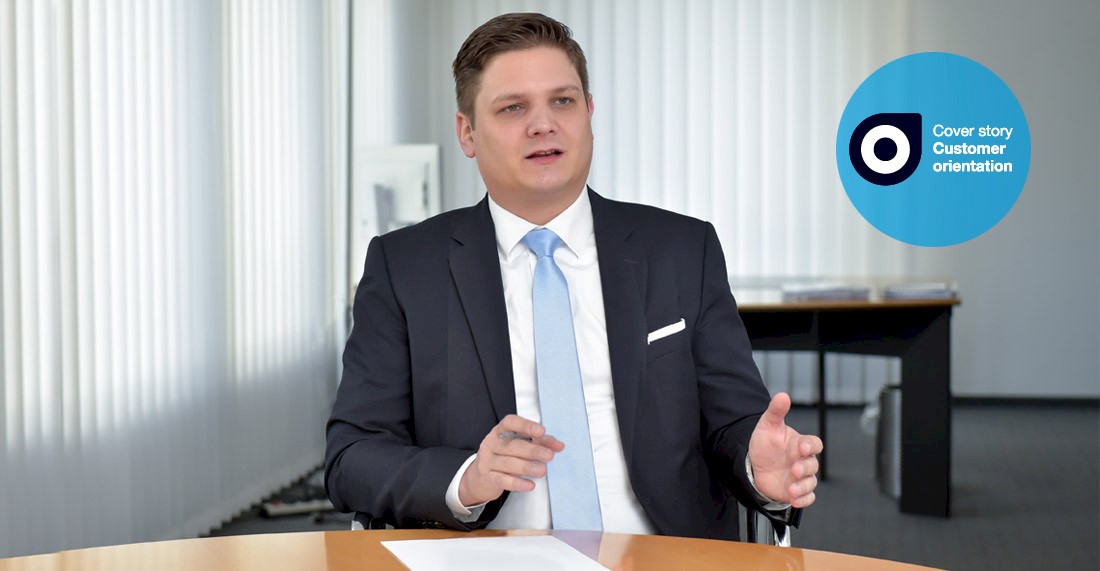Interview
"Always driven by specific customer needs."
Customer orientation as the Value of The Year is currently the focus of numerous activities at Mannesmann Line Pipe. Sales Area Managers Michael Kosfeld and Thorsten Bösch discuss the subject with Head of Quality Assurance Dr. Hendrik Löbbe. They also explain and discuss why ‘internal customer relations’ are so important in their external effect.
Customer orientation has always been prominent at Mannesmann Line Pipe. What’s the Company’s current position?
Michael Kosfeld: Customer orientation obviously isn’t something you can institute by decree from one day to the next. In my view, it has long been part of our corporate culture and always highly individually and personally geared to specific customer needs and in some cases in very different ways.
Thorsten Bösch: In view of the advance of globalization and the fast pace of the worldwide procurement market, customer orientation is growing in importance. With us as their partners, our customers want to successfully address this trend day after day. For this we have to be aware of our customers’ expectations, requirements and needs so that we can then offer tailor-made product and service solutions.
Dr. Hendrik Löbbe: A highly intriguing issue associated with this subject is the basic definition of ‘customer’. We distinguish three levels. First of all, there is the ‘end customer’ with whom unfortunately we are not always in close contact owing to our sales structure. Nevertheless, we put a lot of effort into scoring well in this area. Because we strongly support the ‘middle level’ of our global agents and traders, whom we see less as customers than as colleagues. And, last but not least, we are also concerned with ‘internal customers’ within our own Company and our Group.
Internal customers? Who are they?
Löbbe: In Salzgitter AG’s mission statement YOUNITED, ‘customer orientation’ is the Value of the Year for 2017/2018. In connection with the implementation scheme, we’ve been looking for the most important interfaces between employees and between departments – internal customer relations mainly come into play precisely here. However, we don’t want to solely focus on ourselves but also wish to optimize our structures and processes so that we can effectively satisfy external customer wishes.
Bösch: This way we want to ensure that all our processes run smoothly here and the various departments work together well and communicatively. And we base this cooperation on the principle of customer orientation so that we treat the up- and downstream departments with the same care as we treat our external customers.
How is the external customer structure composed at Mannesmann Line Pipe?
Kosfeld: What distinguishes our customer structure is that there’s no such thing as a typical customer. In addition to the end customers who are served with line pipe for oil, gas and water, as well as OCTG, district heat pipe and structural tubing, there are also traders, further processors and users. And all this on a global scale – in markets that can operate in very different ways from one country to the next and need to be individually served.
.
Because of our differentiated customer structure, the satisfaction parameters are very different for each area.Michael Kosfeld
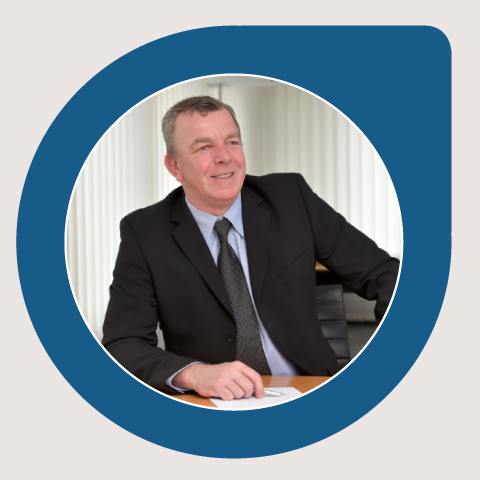
Michael Kosfeld,
Business Area Manager Sales
A Rhineland native, he grew up in Brazil. In the course of his over 30-year service for the Group, he has held positions in sales for various Mannesmann and Salzgitter companies at home and abroad. As Area Sales Manager for oil, gas and water line pipe and OCTG, he is the most important contact for customers in the USA, Canada and Mexico.
.
We want to and have to optimize our internal structures in the interests of the customer and convert change into genuine and tangible customer benefits.Dr. Hendrik Löbbe
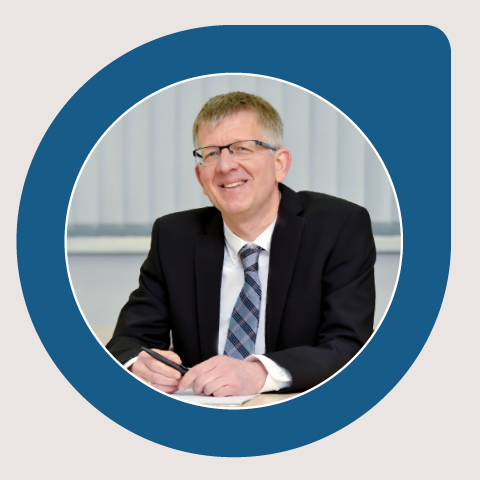
Dr. Hendrik Löbbe, Head of Quality Assurance
Dr. Hendrik Löbbe studied mechanical engineering followed by a doctorate in engineering science. He then started at Mannesmann Line Pipe as a plant engineer in Quality Assurance with the emphasis on research & development. Since 2007, he has been Head of Quality Assurance at the Hamm location, where he is responsible for the company’s quality management.
What will change due to the Group customer orientation drive?
Bösch: We’ve been interviewing the relevant contact persons specifically about the needs of our customers. The evaluation of the results has already resulted in the development of measures for generating individual potential for improvement. We thus want to achieve the best possible outcome for every single customer.
Löbbe: What’s important on the internal side is to grasp what the internal customer actually needs and doesn’t need. In dialog we’ve experienced quite a few »aha!« moments. Together with the consideration of internal customer-supplier relations, it’s also a question of consolidating the amended structures, optimizing our processes and integrating them into improved standards.
What time frame do you see for the envisaged implementation?
Bösch: Customer orientation is an ongoing and living process. This is why implementation and improvement can and must never come to an end in this area but can only ever be seen as an interim step on the way to the next level. Just as customers change, so do their needs.
Löbbe: Customer orientation as the Value of the Year is of course currently very much the focus of numerous activities in this context. At the end of the day, however, it’s also a matter of sharpening awareness of customer orientation in accordance with our mission statement and, over and above this, establishing it as an action guideline for daily implementation and beyond.
How can customer satisfaction be at all measured?
Kosfeld: Because of our differentiated customer structure, the satisfaction parameters for each area are very different. What counts for an oil and gas line pipe trader is maybe irrelevant for a steel construction company because it has entirely different needs.
Bösch: Because we want to set our priorities correctly in this area and at the same time see where we stand, we regularly survey our customers. And to create the necessary preconditions for this, we regularly hold workshops, both within the company and in cooperation with our customers, in which we create the necessary framework for instilling the concept of customer orientation with life.
Numerous activities associated with customer orientation have been running for many years. Is any attention still paid to them?
Bösch: What was until recently considered something special by our customers is now standard and thus regarded as a permanent fixture. This implies at the same time that we are continuing to develop our products and services for the benefit of our customers.
Kosfeld: Our customers and their structures are also constantly developing. Numerous activities have been outsourced to the end customer over the years in a bid to cut manpower and costs. In this process, we are not only in demand as a supplier but have also seen the signs of the times well in advance and acted accordingly. Much of what we do today in our customers’ interests used to take place on the customer’s side. This is now in many cases seen as a natural service provided by the supplier.
On the subject of outsourcing and cost cutting – can Mannesmann Line Pipe actually still afford to have its own globally active sales employees?
Kosfeld: Being close to the customer is all the more important as products become, on the face of it, increasingly interchangeable. In some cases, the value of our products reveals itself of course only in their application and after decades of reliable and trouble-free operation. So precisely for this reason it is ultimately our sales employees and agents worldwide who make the decisive difference. Personal service on the basis of many years of experience and technical expertise – that’s what our customers appreciate. And not only when they tour our plants or attend pre-production meetings in Hamm or Siegen, but above all in view of our presence on site worldwide. From planning, customs clearance and logistical handling through to technical consultations during application on site.
Bösch: Numerous customers additionally value the support from our product managers who are fully conversant with all the technical details – from the material and grades through to the best-suited application process. It is precisely on this basis that we can live up to our reputation as the dependable and solution-driven partner of our customers.
The product managers used to be employees of Technical Customer Service. What has changed for the customer here?
Löbbe: The employees of Technical Customer Service used to be assigned to the quality departments in Hamm and Siegen. Now, as product managers, they are much more strongly integrated in our sales structure. This means that they are much more involved in daily sales business, experience processes and project progress and are de facto closer to our customers. At the same time, they continue to interface with the quality and R&D departments while also being integrated in innovation management and business development and processes.
In what way does digital change impinge upon customer orientation?
Löbbe: Digitization opens up totally new opportunities for companies. For example, it lays the foundations for transforming a function-based into a process-based organization. By switching to SAP 10 years ago, we took a necessary and important step toward the digitization of our processes. Kosfeld: To a large extent, the way we do business today is entirely different to, say, 10 or 15 years ago. Email and smartphones are part and parcel of everyday activities. Video conferences are replacing real-life meetings that were often associated with time-consuming long-distance travel. At the same time, the pace has picked up and every inquiry, every query, every item of desired information has seemingly acquired the same status. Here, again, I see our employees as important interfaces with our customers by assessing things appropriately, setting priorities and drawing the right conclusions in the interests of our customers.
.
In view of the advance of globalization and the fast pace of the worldwide procurement market, customer orientation is growing in importance.Thorsten Bösch
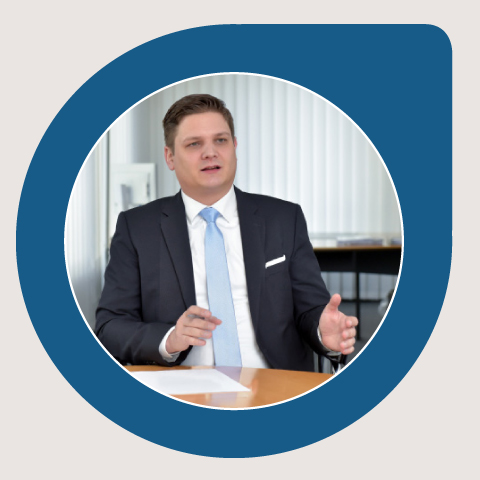
Thorsten Bösch,
Business Area Manager for Structural Tubes, Standard Pipe, District Heat Pipe and MSH Sections
Thorsten Bösch is an MBA, Dipl.-Kfm. (FH) and Lean Six Sigma Master Black Belt. He started his career in 2005 at a precision steel tube trading company mainly serving the automotive industry. After 12 years in various positions through to general manager, he took charge of structural tubes, standard pipe, district heat pipe and MSH sections at Mannesmann Line Pipe in May 2017.
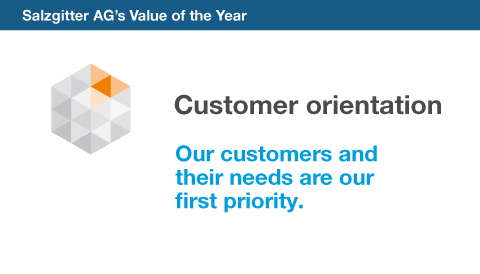
YOUNITED – The Mission Statement of Salzgitter AG
The Salzgitter Group has become an innovative power in the international steel industry. It aspires to rank and to remain among the best in steel and in technology. Its workforce and management alike are committed to achieving this goal. To guide them on their way, they have developed a mission statement comprising their vision of themselves, their principal aims and corporate philosophy. For the last four years, a certain aspect of the mission statement has been highlighted as the Value of the Year in order to achieve this ambitious objective. The initiative in 2017/2018 is »Setting a Clear Course towards the Customer.«
In what areas does customer orientation run up against its limits?
Kosfeld: Transparency and the observance of compliance guidelines are the basis for and an important part of our customer orientation. If customer orientation is interpreted to mean that these rules can be overridden, then we inevitably run up against our limits.
Löbbe: Of course customer orientation must not be allowed to become a be-all and end-all – ultimately it has to add up for everyone concerned. So when focusing on our customers, we must not lose sight of our own principles. At the end of the day, this also means being frank with the customer and honestly saying so when his ideas are unrealistic and cannot be implemented as such.
Bösch: Customer orientation always requires customer participation. Only when customers communicate their needs to us and involve us early on in decision-making processes can we see to it that their wishes are effectively fulfilled. If the customer refuses, for whatever reason, this inevitably limits our opportunities and our scope.
Where do you currently see the biggest challenge when it comes to customer orientation?
Kosfeld: All things being equal – internationally. We make no secret of the fact that the price at the end of the day always is a crucial factor. The energy turnaround, subsidies and cheap imports have caused severe upheaval internationally in some areas. We have to make it plain to our customers where we ourselves have to step in and accept responsibility and where we don’t. This also applies, incidentally, to the supply chain. Continuing to be in demand as a reliable supplier in this context is in my view a major challenge for the future.
Löbbe: We want to and have to optimize our internal structures in the interests of the customer and convert change into genuine and tangible customer benefits.
Bösch: The biggest challenge will always be that of supplying the ordered goods in the required quantity and quality at the specified time. This has always been our aspiration and will continue to be so in the future. We don’t measure our performance with that of other suppliers – our yardstick is customer satisfaction.
